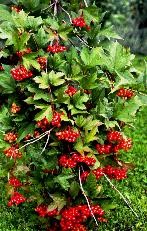Or American Bush-Cranberry
Secwepemc name: Berries: t’anís; Bush: t’niséllp.
 Secwepemc Elder Mary Thomas made a syrup from these berries. First she boiled them to extract all the juice, then she put all the berries in that one strainer, “it’s got water, that crushes it or extracts the juice, and it’s just pure juice when it comes out. And I put that in another pot and I boil it, and I just put a little bit of sweetener and I set it out, and it makes a nice syrup….” The berries can also be simply eaten fresh when they are ripe. Mary Thomas said that the leaves and stems of highbush cranberry were collected in spring. They could be dried then used in the form of a tea as a pain reliever. Willow grouse and other birds like to eat the berries of this bush.
Secwepemc Elder Mary Thomas made a syrup from these berries. First she boiled them to extract all the juice, then she put all the berries in that one strainer, “it’s got water, that crushes it or extracts the juice, and it’s just pure juice when it comes out. And I put that in another pot and I boil it, and I just put a little bit of sweetener and I set it out, and it makes a nice syrup….” The berries can also be simply eaten fresh when they are ripe. Mary Thomas said that the leaves and stems of highbush cranberry were collected in spring. They could be dried then used in the form of a tea as a pain reliever. Willow grouse and other birds like to eat the berries of this bush.
Ecological requirements: Requires moist, nitrogen-rich soils in drainage or wetland areas; riverbanks, shorelines, etc. Considered a threatened species in some areas. A few bushes remain on the trail near the river bend.
![]()
